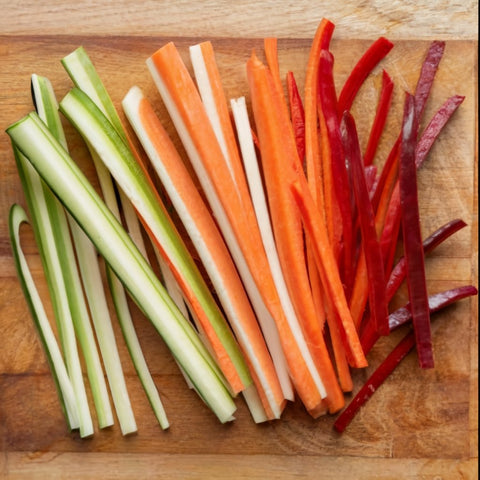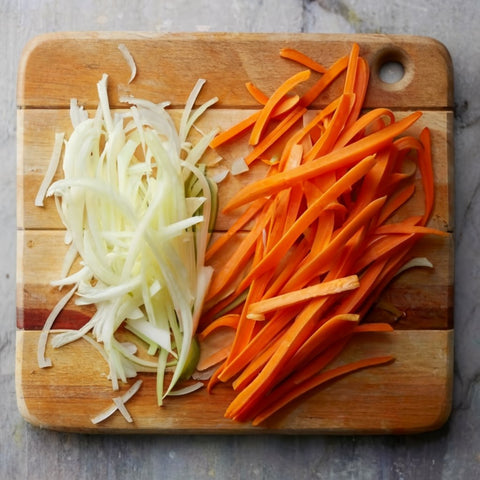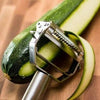The julienne cut is a classic French method of chopping vegetables and fruits into matchstick-style pieces. The julienne cut stands as a testament to precision and artistry. This technique, originating from French cuisine, involves turning ordinary vegetables into delicate, uniform strips that elevate the visual appeal and texture of any dish. Whether you're a seasoned chef or a passionate home cook, mastering the julienne cut is a skill that can take your culinary creations to new heights. In this comprehensive guide, we will delve into every aspect of this technique, from the basics to advanced tips, ensuring you become a julienne cut maestro.

With this simple step-by-step Julienne Cut guide, you will be a French knife technique master in practically no time!
Julienne veggies can be challenging, and it requires a lot of patience. Julienne veggies makes your salads, stir fries, side decorations and dishes very appetizing. Julienned vegetables can be a great addition to your recipes. You can make julienne ribbons from carrots to cucumbers and zucchini to bell peppers in fine, thin strips.
As a food enthusiast with years of experience, I can attest to the transformative power of the julienne cut in the culinary world. It's a technique that not only enhances the visual appeal of a dish but also elevates its overall taste and texture. The precision required in achieving uniform strips is akin to an art form, and when done right, it can truly set a dish apart. I've had the pleasure of incorporating julienne cuts into a myriad of recipes, from vibrant salads to hearty stir-fries, and the results have always been nothing short of spectacular. The julienne cut adds a level of sophistication to any dish, making it a staple in my culinary repertoire. So, for any aspiring chef or passionate home cook, mastering this technique is a worthwhile endeavor that will undoubtedly take your culinary creations to a whole new level of excellence.
When I eventually came to discover the julienne cut method I understood how much this technique is super easy, even for home cooks!
What is a Julienne Cut?
The julienne cut, also known as matchstick cut, is a culinary French knife technique that produces long, thin strips of vegetables or fruits. The julienne strips are usually about 2-3 inches long and 1/16- to 1/8-inch thick. These strips are characterized by their uniformity in size, creating a visually appealing and texturally pleasing element in dishes.
It’s perfect for making super slim, crunchy pieces of carrot, cucumber, french fries, or bell pepper for diverse recipes, salads and garnishes.
Tools To Julienne
Kitchen knife. An 8-inch chef’s knife is ideal. It should be a very sharp knife.
Wooden cutting board. Wood is an easier board to cut vegetables. It’s much more stable, allowing for precise cuts.
Vegetable peeler. You need this for peeling the vegetables before you start to cut them.
Julienne peeler. My favourite tool to make julienne strips from any vegetable.It’s durable and helps you make perfectly uniformly julienned vegetables in a few seconds.
Achieving a perfect julienne cut necessitates the use of the right tools. A sharp chef's knife or a dedicated julienne peeler is essential. Additionally, investing in a sturdy cutting board with a non-slip surface ensures safety and accuracy. I really like to julienne veggies with a julienne peeler instead of a knife. It’s super easy to make the julienne strips when you have a high quality julienne peeler.
The big advantage of a julienne peeler is its ability to create thin strips more efficiently and effortlessly. A julienne peeler can cut almost all kinds of vegetables easily. Whether it is large or hard. The julienne peeler has much more outcomes when it comes for home use. It’s a versatile tool and you can peel veggies into thin ribbons, making high quality salads and side dishes. In addition, when it comes to cleaning, the julienne peeler is much easier to clean.
How to Julienne Cut With a Knife
First, wash your vegetable of choice well, to remove any leftover dirt or pesticides still lingering on the surface. For vegetables like carrots or cucumbers, trim the ends to create a flat surface.

Cut the vegetable into 2- to 3-inch long pieces, depending on the desired julienne length. Cut away and discard the stem or root end.
Next, set the sliced pieces cut-side down on a cutting board and trim away a thin slice from one rounded side. This helps to square it off and make for a stable base to lay down on the cutting board.
Stack a few of these slices together at a time, and put them back on the board cut-side down. Cut them once more into 1/16- to ⅛-inch ribbons, creating a uniform matchstick julienne strips.
How to Julienne Cut With a Julienne Peeler
As I’ve already mentioned, I prefer to make julienne strips with a julienne peeler. It’s much easier and the results are perfect.

To make julienne riboons with a julienne peeler, press and hold the vegetable down firmly on a cutting board and slide the julienne peeler from the top downwards, making even slices all the way through the fruit or vegetable. Use your free hand to hold the veggie down at the top, so that you keep your fingers away from the sharp blade.
Once you reach the end, shake the slices off your peeler and return to the top, pulling the blade all the way down through the vegetable again. Repeat this process until you’ve julienned your entire vegetable.
You can julienne various veggies like: carrots, zucchini, sweet potatoes, squash, turnips, cucumbers, beets, cabbages, potatoes and more.

FAQs (Frequently Asked Questions)
Can I achieve a julienne cut with any type of knife?
Yes, while a chef's knife is the preferred tool, a dedicated julienne peeler can also produce excellent results.
Are there specific vegetables that are best suited for julienne cuts?
Firm vegetables like carrots, zucchinis, and cucumbers are ideal for julienne cuts due to their ease of handling and uniform texture.
How do I store julienne-cut vegetables?
Place them in an airtight container or a resealable plastic bag and store them in the refrigerator. They're best used within two to three days for optimal freshness.
Can I julienne-cut fruits for desserts?
Absolutely! Firm fruits like apples, pears, and melons can be beautifully julienne-cut for salads, garnishes, or fruit arrangements.
What are some dishes that prominently feature julienne-cut vegetables?
Popular dishes include stir-fries, salads, and sushi rolls, where the julienne cut adds both visual appeal and a delightful crunch.
Conclusion:Julienne cutting is more than a culinary technique; it's an art form that enhances the dining experience. Whether you're a seasoned chef or a cooking enthusiast, mastering this skill will bring a new level of sophistication to your dishes.






